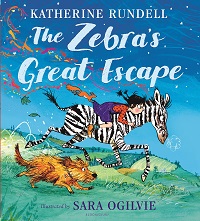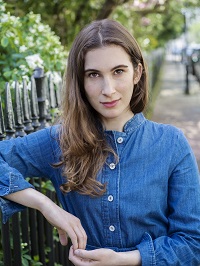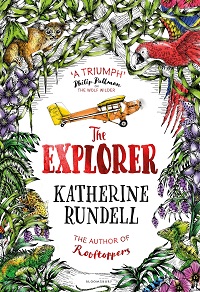
Authorgraph No.255: Katherine Rundell
Katherine Rundell interviewed by Imogen Russell Williams
 The tightrope-walker, scholar and writer Katherine Rundell is the author of bestselling books for children including Rooftoppers, The Wolf Wilder, The Explorer and The Good Thieves, as well as two works of non-fiction for adults, Why You Should Read Children’s Books, Even Though You Are So Old and Wise, and Super-Infinite, a biography of John Donne. Her work has won the Costa Children’s Book Award, the Waterstones Children’s Book Prize and the Blue Peter Book Award, among others, and has been translated into thirty languages. Her new picture book, The Zebra’s Great Escape, illustrated by Sara Ogilvie, is published in September 2022. Imogen Russell Williams interviewed Katherine for Books for Keeps.
The tightrope-walker, scholar and writer Katherine Rundell is the author of bestselling books for children including Rooftoppers, The Wolf Wilder, The Explorer and The Good Thieves, as well as two works of non-fiction for adults, Why You Should Read Children’s Books, Even Though You Are So Old and Wise, and Super-Infinite, a biography of John Donne. Her work has won the Costa Children’s Book Award, the Waterstones Children’s Book Prize and the Blue Peter Book Award, among others, and has been translated into thirty languages. Her new picture book, The Zebra’s Great Escape, illustrated by Sara Ogilvie, is published in September 2022. Imogen Russell Williams interviewed Katherine for Books for Keeps.
You have written passionately in defence of adults reading books for children, but you come from a studious background of reading very grown-up books yourself. How did you first find yourself shaping a story for children?
It seems to me that children’s books at their best need a lot of the same skills as those of a scholar; it’s always an act of imaginative casting yourself into another self. When I write for children, I write both for myself, aged now, with all the desires that I have, the things in life that I want, and an acknowledgement of human frailty and cruelty and chaos; and I also want all the things that I wanted as a child, a sense of glee, delight, food, texture, atmosphere. I think that the ideal children’s book feels like an act of both enormous imaginative work – you’re imagining what it was to be a child, what might please a child – and also enormous intellectual work, because you are trying to tell the truth to children about the world in a way that they will find workable. That sounds slightly grand, but I mean it in the way that things like The Tiger Who Came to Tea tells the truth about the comedy of the world, and its surrealism. My academic work doesn’t feel that different to me from writing for children. Obviously it involves vastly more footnotes, but I think the best academic work also uses a huge amount of imagination. To me, even though obviously they are worlds apart, Latin satire and picture books often feel like they’re on the same continuum: of trying to find a way to explain something fascinatingly important.
Your child protagonists are permitted a great deal of wildness, peril and secrets. Do you ever worry about offering too much dangerous freedom on the page?
I very, very truly don’t. I think children are themselves often very good at doing dangerous things carefully, and I think a life devoid of danger in  childhood is a life which in adulthood risks feeling a little bit thwarted and smaller than it might otherwise have been. So much of my books deal with fear – I think it’s quite explicitly stated in The Explorer – ‘You’re right to be afraid – do it anyway’. And often we’re really more interested in emotional danger, but that isn’t a plot. So often things like ‘drive an aeroplane out of the Amazon rainforest’ are also standing in for the idea of other kinds of challenge that children face. There’s a bit in the book where it says ‘He flew towards fear, and towards hope’ – and that’s very literal, he is in an aeroplane. But I’m hoping that as children get older they might look back on that book and realise that it’s also attempting to offer them some kind of metaphorical map. I love the way that Frank Cottrell-Boyce says ‘What are children’s books for? They’re to teach you how to be happy.’ – and I think one of the ways to be happy is to be able to embrace a certain amount of risk. (I should also admit that I have been held responsible for a fractured ankle and a badly sprained wrist from children who went rooftopping, but you know, that is genuinely my hit rate in thirteen years of writing children’s books, and I just don’t think that’s that bad!)
childhood is a life which in adulthood risks feeling a little bit thwarted and smaller than it might otherwise have been. So much of my books deal with fear – I think it’s quite explicitly stated in The Explorer – ‘You’re right to be afraid – do it anyway’. And often we’re really more interested in emotional danger, but that isn’t a plot. So often things like ‘drive an aeroplane out of the Amazon rainforest’ are also standing in for the idea of other kinds of challenge that children face. There’s a bit in the book where it says ‘He flew towards fear, and towards hope’ – and that’s very literal, he is in an aeroplane. But I’m hoping that as children get older they might look back on that book and realise that it’s also attempting to offer them some kind of metaphorical map. I love the way that Frank Cottrell-Boyce says ‘What are children’s books for? They’re to teach you how to be happy.’ – and I think one of the ways to be happy is to be able to embrace a certain amount of risk. (I should also admit that I have been held responsible for a fractured ankle and a badly sprained wrist from children who went rooftopping, but you know, that is genuinely my hit rate in thirteen years of writing children’s books, and I just don’t think that’s that bad!)
There is also a lot of blood, snot, wolf pee and sloth poo in your books. Are you deliberately unsanitary?
Yes, very much so! I think there is so much joy in a certain amount of untrammelledness. But also, anyone who’s ever met a child knows that children are just quite grubby, and constantly attracted to things that will be sticky, that will be mildly disgusting; and I don’t know why exactly, but I do know that I felt it myself as a child – the longing to be up close with things, and feel the mark of the world, with scraped and muddy knees. I took pleasure in having slightly grubby feet most of the time. I think there’s a kind of delight in not being afraid to get messy, because in getting a little bit messy, you have crossed a boundary away from the interdictions of perfection, the imperative of perfection. And I think that keeping dirt at bay would take so long, and it would be such an overwhelming focus, that just letting a little bit in, letting kids be a little bit filthy, opens up so much space for more exciting adventures.
You’ve addressed many ‘classic’ tropes in your books – being sent away to school, orphans in search of parents, survival and exploration, circuses and heists. What challenges have you faced in updating these tropes?
I am so grateful for the sense that when we write now, we have a duty of care to present the world as it is, and not only the upper middle class white society that dominated children’s fiction for the first half of the twentieth century. In practical terms, it’s been a conscious process of self-assessing, and trying to do at every stage everything you can to ensure that you are respecting a diverse world, that has different colour, and children with visible differences. I really appreciate and cherish the use of a sensitivity reader, because you’re being offered valuable information about a [context] around which you did not grow up. For instance, in The Good Thieves, I wanted to write about American racism – in passing. I didn’t want it to be a book in which only my Black character experiences a trauma that the other characters are not exposed to. But of course you can’t write about America in the 1920s without acknowledging how dangerous and cruel it was for children in racialised bodies. And I had two different sensitivity readers, and the things they pointed out were really, really valuable. For instance, one of them was that my Black character was the tallest of the children, because I had imagined him as a trapeze artist, flying through the air, and she said ‘you won’t necessarily think it, but there’s a real trope about the strong, muscular Black child – and so maybe he could just not be the tallest? Maybe he could be the small, lithe, darting one?’ And so that is what Samuel is, in The Good Thieves. And I really appreciated just being given these insights that I otherwise would not have known. I have been dismayed by the clamour that it is a muzzling of artistic freedom. It’s just extra information; and if you’re in any way scholarly inclined, it’s an incredibly valuable thing to have.
“Wolves, like children, are not born to lead calm lives”. How much in need of ‘wilding’ do you think today’s children are, especially given the toll of the pandemic?
I think the pandemic is the key thing here. Children made such a huge sacrifice for the good of the nation, and I salute the grace and patience of so many of the children I know, who met that need with real generosity. But it has been so hard for them, and to have to be afraid of the kind of clumsy wild running about that’s so key to childhood – we urgently need now to offer them recompense, and I despair slightly of that being forthcoming. But I think children deserve – not just deserve, but urgently need – that feeling of wildness, of not being constantly hemmed in by restrictions and regulations – and I really really hope that we can find a way to get those spaces for them.
You’ve written mainly for readers of (roughly) eight to twelve – but you have a picture book coming out soon, The Zebra’s Great Escape, illustrated by Sara Ogilvie. What’s it like, writing for much younger readers?
I loved writing Zebra! It was such a huge delight. A picture book is shorter, it’s easier to keep the entirety of it – structure and character and pace – in your head. I could ‘read’ Zebra to myself in memory, page by page, in a way that I couldn’t for any of my novels. The pictures do half the storytelling! And with a good picture book, the pictures are always narratively active; they always are telling not just the story on the page that I’ve written, but also more than that. For instance, Zebra is about a girl who discovers a zebra whose parents were kidnapped. She’s playing on a swing in the play park, and he startles her and she flies off and bumps her head, [and then] when he breathes on her, she can understand what he’s saying. And presenting that concept, that a swirl of colours becomes a form of storytelling – many illustrators might well have told me to f*** off, but Sara was just so brilliant in the way she rose to it. And then there were all these little things that I wouldn’t have thought of; like when all the animals are ranged in fury around [the villain] Mr Spit, a lot of the very small animals are riding on the foreheads of a lot of the very large animals, and it makes a fabulous battleground scene. It’s not in the text – that’s just Sara being brilliant!
You’ve been writing very successful children’s books for thirteen years now. How do you think the landscape of children’s literature has changed in that time?
It’s very trite, but people often say this is a golden age of children’s literature, and I think there is a huge amount of truth in that. I think there is real focus and ambition in the children’s books that are being produced today; there’s such a glorious range of ideas and imagination. I think that we have finally realised that of course we urgently need diversity of people from different racial backgrounds – and I think we have so far to go. I’m so grateful though that we’ve made a beginning. But we also need so much more diversity of stories, of people coming from different traditions, of people from different classes…We are still a very middle-class profession, children’s writing – I think that’s to do with money, and the fact that it doesn’t make very much, unless you happen to be very fortunate. But I do think it has got so much better. There’s just so much more – we have a flood of children’s books at the moment, and that has been a real joy to see. And I know some think it’s a saturated market, but if you think of it not in terms of the marketplace, but just in terms of the cornucopia being offered to kids, that’s a real, formidable delight.
You recently published Super-Infinite, a biography of John Donne for adults. It sparkles with your characteristic fervent, evident delight in your subject, but it is definitely a Grown-Up Book. How differently did you have to operate when writing it?
The main thing is that I have loved John Donne ever since I was myself a child, and it really did feel like if I’d got it wrong, I would be doing harm to a great man; to a great person, who had seen a great deal about the world. But also, I had one shot. No one’s going to read two books about John Donne from me. So I had one shot to make people fall in love. He both thought we were this kind of appalling disaster – that we were cruel and mean and spiteful, and…in the terms of the seventeenth century, sinful. But he also thought we were staggeringly sexy, funny, wildly capable of intelligence, imagination, boldness – and he also thought that we were infinite. He had a sense of us as miraculous, and I love that, and it is also something I believe utterly about people, and I think that’s why I’ve loved him ever since I was very young – he shaped and matched my sense of what people are. And that’s the sense that I want to offer kids. ‘You’re right to be afraid – do it anyway’ has its colloquy in a sense of ‘the world is miraculous and very difficult’. It is the most difficult thing in the world to be alive, and it is also so staggeringly astonishing that it really behoves us to be astonished daily. I want to offer kids that; that sense that yes, we are chaos and confusion, but greater than the chaos is the miracle.
Imogen Russell Williams is an author and a journalist and editorial consultant specialising in children’s literature and YA.
Books mentioned
The Zebra’s Great Escape, illustrated by Sara Ogilvie, Bloomsbury Children’s Books, 978-1408885758, £14.99hbk
The Explorer, Bloomsbury Children’s Books, 978-1408882191, £7.99 pbk
The Good Thieves, Bloomsbury Children’s Books, 978-1408882658, £7.99 pbk
Super-Infinite: The Transformations of John Donne, Faber & Faber, 978-0571345915, £16.99 hbk




